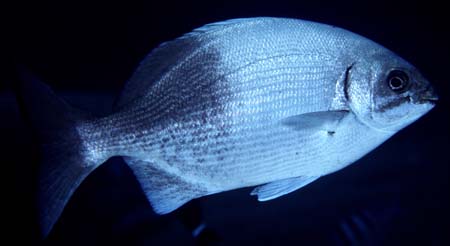
Hanauma Bay, O`ahu.
3 ft. |
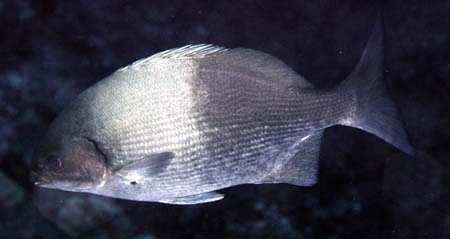
Hanauma Bay, O`ahu 3 ft.. |
|
BICOLOR or HAWAIIAN
CHUB
Kyphosus hawaiiensis Sakai & Nakabo, 2004
Now here's something new--a fish that
so greatly resembles the common Gray Chub that ichthyologists never
suspected it to be a separate species. Recently, however, two Japanese
researchers, Keiichi Sakai and Tetsuji Nakobo, announced that the
species which up to now has been called Kyphosus bigibbus
is in fact a complex of species. (Ichthyol. Res. 2004, 51: 20-32)
They arrived at this conclusion by performing detailed examinations
of museum specimens.from all over the world. Specimens from Hawaii,
thought to be "Kyphosus bigibbus," were in fact
separable into two species that manifested very subtle but consistent
anatomical differences. It turns out that neither was bigibbus
and both were undescribed. Sakai and Nakobo called one "hawaiiensis"
because it occurs only in the Hawaiian and Line Islands, and the
other "pacificus" because it is widespread in the Pacific.
The
more common of the two is pacificus. This is the one shown
in all the books under the name Gray Chub. (I've included a photo
at the bottom of this page.) The other is this month's
Fish of the Month. To tell the difference between the two, ichthyologists
must perform tedious counts of scales and gill rakers on lab specimens.
Luckily, divers and snorkelers can usually tell one from the other
fairly easily by color pattern. Like the Gray Chub, the Hawaiian
Chub is basically bluish gray, but it typically darkens the posterior
half of its body to varying degrees, creating a distinctive half-light
half-dark pattern. The habits of the two also differ. The Hawaiian
Chub lives in small groups in the surge zone at the top of reefs
and dropoffs and can be found reliably in the same locations over
a period of years, thus is probably territorial. The Gray Chub,
by contrast, often swims in large schools and appears to be much
more mobile. Though certainly not rare, the Hawaiian Chub is patchily
distributed and rather particular about where it lives. It sometimes
aggregates with the Highfin Chub (K. cinerascens), with which
it may share habitat. On calm days, snorkelers at Hanauma Bay, O`ahu,
can see Hawaiian Chubs at several usually-turbulent spots right
on top of the fringing reef in only a few feet of water. The species
attains about 14 in. and is restricted to the Hawaiian and Line
Islands.
|
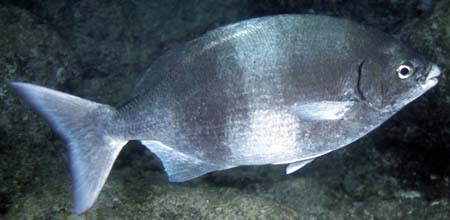
Hanauma
Bay, O`ahu 3 ft. |
|
The
photo above shows another color pattern which I believe belongs
to the Hawaiian Chub, though I don't know for sure. Maybe it's the
as-yet-undescribed 5th species that Sakai and Nakobo are working
on.
|
CHUB
REVOLUTION!
The species we call Gray Chub in Hawaii (illustrated below and formerly
called Kyphosus bigibbus) was given the scientific name Kyphosus
pacificus by Sakai and Nakobo. However, Dr. John E. Randall
has determined that there is a Hawaiian specimen of this species
in the French national museum that in 1880 was named K. sandwicensis.
That means that the older name prevails, at least in Hawai`i.(The
old biggibus, for
those of you who are wondering, is still a valid species, now
officially known as the Brown Chub. The Brown Chub occurs
in subtropical locations of the Indo-Pacific such as the Red Sea,
South Africa, Australia, Japan and Easter Island, but not Hawai`i.) If
you are now thoroughly confused by these fishes that look so much
alike, here is a list of chubs of the genus Kyphosus known
so far from Hawaii. Photos below.
Kyphosus
sandwicensis- Gray Chub
ID: often lightish stripe along curve of back; yellow or white color
variants
(This is the fish Sakai and Nakobo called pacificus in their
paper and that is listed as bigibbus in current Hawai`i fish
books)
Kyphosus hawaiiensis
- Bicolor or Hawaiian Chub
ID: half & half color pattern pattern, or dark with light central
bar.
(This is the new species)
Kyphosus vaigiensis
- Lowfin Chub or Brassy Chub
ID: more prominent stripes, often some brassy yellow around mouth and
gill cover; becomes dappled or spotted when aroused. (This name
is unchanged)
Kyphosus cinerascens
- Highfin Chub or Snubnose Chub
ID: snub nose and high soft dorsal fin; silvery to dark with some
scales darker than others, producing unkempt, patchy appearance.
(This name is unchanged)
See
also Sectator
ocyurus - Rainbow Chub
In addition to these, Sakai and Nakobo say that there is yet another
chub in Hawai`i which they are in the process of describing. Stay
tuned....
|
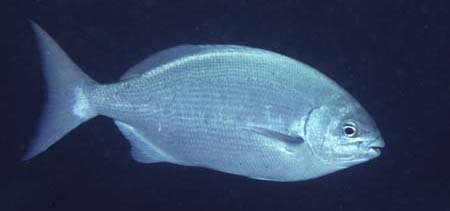
Kyphosus sandwicensis - Gray Chub |
|
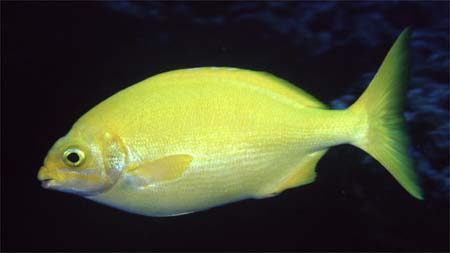
Kyphosus sandwicensis
- Gray Chub - yellow variant
|

Kyphosus vaigiensis
- Lowfin or Brassy Chub (normal coloration) |
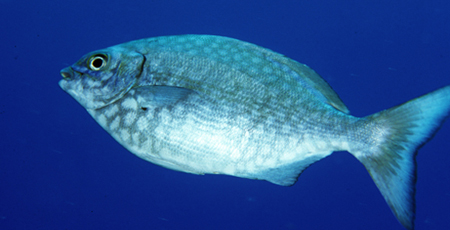
Kyphosus vaigiensis
- Lowfin or Brassy Chub (when aroused)
photo courtesy
of Mike Severns |
|
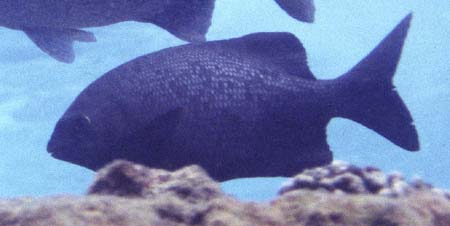
Kyphosus cinerascens
- Highfin or Snubnose Chub
|
|




